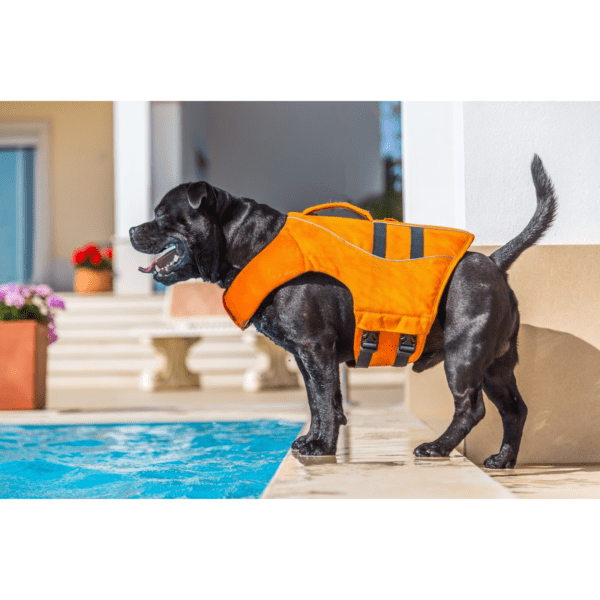HEATSTROKE CAN KILL, AND FAST
Most pet owners realize that keeping pets in hot cars can kill them…but not many realize just how quickly the effects of heatstroke can set in for a dog or cat. Heatstroke is a condition animals begin to suffer gradually, but it accelerates quickly; it’s easy for early signs of heatstroke to go unrecognized, and for the pet to be in an emergency situation within mere minutes.
On warm days, a vehicle acts like an oven. It holds the heat inside, and that heat becomes very intense even on days that don’t seem too warm. On an 85-degree day, for example, even with the windows open, the temperature inside a car can climb to 102 degrees in 10 minutes, and to 120 degrees in 30 minutes. With the humidity we experience here on the shore, it may go even higher. Because a dog’s normal body temperature is 101-102.5 degrees Fahrenheit, he can withstand a body temperature of 107-108 degrees for only a very short time before suffering irreparable brain damage…or death.
The typical signs of heatstroke are:
- Panting
- High body temperature
- Dehydration
- Red mouth/eye membranes
- Rapid, irregular heart rate
- Diarrhea
- Weakness, looking dazed
- Coma
If a pet begins exhibiting any of these signs, contact a veterinarian immediately.
Also, use caution during summer months when leaving animals outside in yards or on porches. Never leave them outside for extended periods of time. Ensure appropriate shade and water are always available. Keep close supervision on your pet when outdoors on hot, humid, sunny summer days. If you see an animal left on a porch or in a yard with no access to shade or with inadequate shelter, contact Talbot Humane if the location is within Talbot county (410)822-0107.
ADMINISTER FLEA PREVENTION PRODUCTS CORRECTLY
There are instances where flea treatment was incorrectly applied to cats causing illness and death. It is vitally important you not use products meant for only dogs on cats, as well as ensuring your are following instructions properly concerning volume and manner of application. Read the directions carefully PRIOR to application, not during application. The application of improper flea products, low-quality flea products, or products applied incorrectly, can cause internal damage or death to your pet. Always consult a veterinarian before purchasing and applying flea products.
KEEP PETS HOME DURING OUTDOOR FESTIVALS
In our areas there always seems to be some sort of festival or event going on. The numerous fireworks displays scheduled, as well as other crowded outdoor events are no places for dogs. Extremely hot weather, paired with immense crowds of people and strange noises and scents, heightens the stress level for many animals; the repetitive, exploding sound of fireworks is enough to make even the calmest animal frantic and sometimes aggressive. Your pet’s body is closer to the asphalt and can heat up much more quickly. The hot pavement can also burn unprotected, sensitive paw pads.
WATER SAFETY
Often people assume every dog knows how to swim, this is not the case. Here are a few water safety tips for your dogs:
- Not all dogs are good swimmers. In fact, some dogs don’t swim well or naturally and can drown as fast (or faster) than a person. Don’t assume your dog will take to the water and be able to stay afloat. Try him out in shallow water before a big excursion.
- Preserve a life. If you’re out in a boat or raft, your dog should have a life preserver on – no exceptions! It not only will keep him afloat, it makes him easier to spot and gives you something to grab if he jumps or falls in.
- Sink or swim? Dogs that are heavy on land are way heavier in the water when you’re trying to pull them back into your boat. Make sure you can handle your dog out of your and his natural environments.
- Keep your dog close! Even dogs that swim well can tire very quickly, even faster than you, because they don’t understand the concept of resting or treading water – they just swim and swim, until they can’t anymore. When swimming with your dog, don’t let your him swim too far away from you, because he could get into trouble quickly.
- Don’t force your dog into the water/ If your dog doesn’t like the water, don’t make him go in! It could scare him and won’t be fun for him at all!
DON’T FORCE EXERCISE
Specifically after a meal or in hot, humid weather. Instead, exercise pets in the cool of the early morning or evening. Be extra-sensitive to older and overweight animals, or those prone to heart or respiratory problems. Bring an ample supply of water along on the walk. How about some “indoor” walks such as at our local PetSmart or other pet-friendly stores. Or fill a kiddie pool with fresh water each day for them to lounge and play! Have a “people pool”? Make sure your pet’s can swim! Some breeds are not known for their aquatic skills- such as bulldogs, pugs, bassets, and dachshunds. If you are the proud parents to one of these breeds make sure to take precautions to ensure their safety around the pool.
BE CAREFUL WHERE YOU WALK
Avoid walking your dog in areas that you suspect have been sprayed with insecticides or other chemicals, or have puddles or spots of auto coolant. The sweet taste of poisonous liquids attracts animals and can sicken or kill them if ingested. Clean any spills immediately or consider using animal-friendly products to help minimize risks.
Pavement gets hot very quickly. If it is too hot for your hand to be held on it for 5 seconds, it is too hot for the pads of your dogs feet too.
We hope you share this information with friends and family. A little planning can save your pet’s life!

